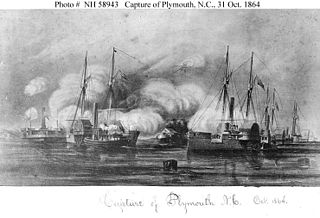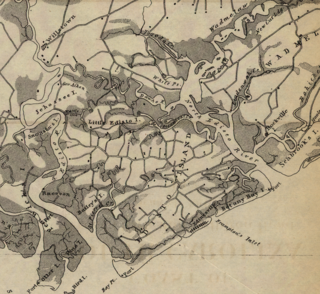
The Battle of Dranesville was a small battle during the American Civil War that took place between Confederate forces under Brigadier General J. E. B. Stuart and Union forces under Brigadier General Edward O. C. Ord on December 20, 1861, in Fairfax County, Virginia, as part of Major General George B. McClellan's operations in northern Virginia. The two forces on similar winter time patrols encountered and engaged one another in the crossroads village of Dranesville. The battle resulted in a Union victory.

The second USS Memphis was a 7-gun screw steamer, built by William Denny and Brothers, Dumbarton, Scotland in 1861, which briefly served as a Confederate blockade runner before being captured and taken into the Union Navy during the American Civil War. She was destroyed by fire in 1883.

The Battle of Secessionville was fought on June 16, 1862, during the American Civil War. Confederate forces defeated the Union's only attempt to capture Charleston, South Carolina, by land. It is noted for the court martial of the Union brigadier general Henry Benham for trying to take James Island, which was against the orders given.

The 52nd Pennsylvania Infantry was a volunteer infantry regiment in the Union Army during the American Civil War.

The Battle of Baton Rouge was a ground and naval battle in the American Civil War fought in East Baton Rouge Parish, Louisiana, on August 5, 1862. The Union victory halted Confederate attempts to recapture the capital city of Louisiana.

The Battle of St. John's Bluff was fought from October 1–3, 1862, between Union and Confederate forces in Duval County, Florida, during the American Civil War. The battle resulted in a significant Union victory, helping secure their control of the Jacksonville area.

The Battle of Plymouth was an engagement during the American Civil War that was fought from April 17 through April 20, 1864, in Washington County, North Carolina.
The following Union Army units and commanders fought in the Battle of Fredericksburg of the American Civil War. Order of battle compiled from the army organization during the campaign. The Confederate order of battle is listed separately.

The state of Rhode Island during the American Civil War remained loyal to the Union, as did the other states of New England. Rhode Island furnished 25,236 fighting men to the Union Army, of which 1,685 died. The state used its industrial capacity to supply the Union Army with the materials needed to win the war. Rhode Island's continued growth and modernization led to the creation of an urban mass transit system and improved health and sanitation programs.
The Battle of Dingle's Mill was an American Civil War battle that took place near Sumterville, South Carolina.

John Lyman Chatfield (1826-1863) was a Union Army colonel in the American Civil War. He was mortally wounded while assaulting Fort Wagner, South Carolina on July 18, 1863, and died on August 9, 1863.
The 4th New Hampshire Infantry Regiment was an infantry regiment that served in the Union Army during the American Civil War.

The Battle of Tulifinny was a military engagement of the American Civil War that was fought from December 6–9, 1864 in Jasper County, South Carolina during Sherman's March to the Sea. Outnumbered five-to-one, a Confederate force led by Major-General Samuel Jones, consisting in part of the entire cadet corps of the South Carolina Military Academy, successfully defended a strategically important section of the Charleston and Savannah Railway from attacks by Union forces. The engagement was one of the rare occasions when the United States Marine Corps fought in combat during the conflict.
The First Battle of Pocotaligo was a battle in the American Civil War fought on May 29, 1862 near Yemassee, South Carolina. The Union objective was to sever the Charleston and Savannah Railroad and thus isolate Charleston, South Carolina.

The Battle of Coffeeville, fought December 5, 1862, was a military engagement of the American Civil War fought near Coffeeville, Mississippi.

The 47th Pennsylvania Infantry Regiment, officially the 47th Regiment, Pennsylvania Volunteer Infantry and sometimes referred to simply as the 47th Pennsylvania Volunteers, was an infantry regiment that served in the Union Army during the American Civil War and the early months of the Reconstruction era. It was formed by adults and teenagers from small towns and larger metropolitan areas in central, northeastern, and southeastern regions of Pennsylvania.

3rd Rhode Island Heavy Artillery Regiment was a heavy artillery regiment that served in the Union Army during the American Civil War.

Edisto Island during the American Civil War was the location of a number of minor engagements and for a time of a large colony of escaped African-American slaves during the American Civil War (1861–1865). Edisto Island was largely abandoned by planters in November 1861 and in December 1861, escaped slaves began setting up their own refugee camps there. In January 1862, armed African Americans from the island and Confederate forces clashed and a Confederate raid in reprisal killed a small number of unarmed African Americans. In February, Union forces were stationed on the island to develop it as a staging area for future campaigns against Charleston, twenty-five miles away, as well as to protect the colony, which would eventually number thousands of African Americans. As Union forces took control of the island, a number of skirmishes occurred, but Confederates withdrew. In June, most of the Union troops left the island in a campaign, which culminated in the Battle of Secessionville. In July, the remaining troops withdrew, and the colony was removed to St. Helena Island. For the rest of the war, a small number of escaped slaves and plantation owners remained and farmed the island, but it was largely abandoned. Near the end of the war, the island was again used as a location of colonies of freed slaves.

CSS Junaluska, also known as Younalaska, was a screw steamer tugboat that saw service with the Confederate States Navy during the American Civil War. Built in Philadelphia, Pennsylvania, in 1860, she was purchased by the Confederates at Norfolk, Virginia, in 1861. Serving off of the coasts of Virginia and North Carolina, she participated in the capture of the gunboat USS Fanny on October 1, 1861, and later in a raid on a Union campsite. She continued to serve along the North Carolina coast until August 1862, when she was sold and broken up.















